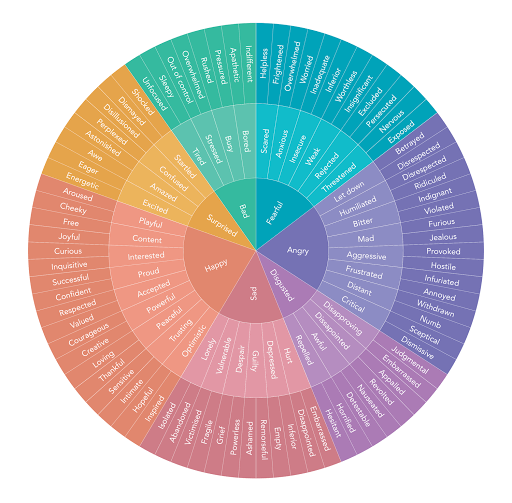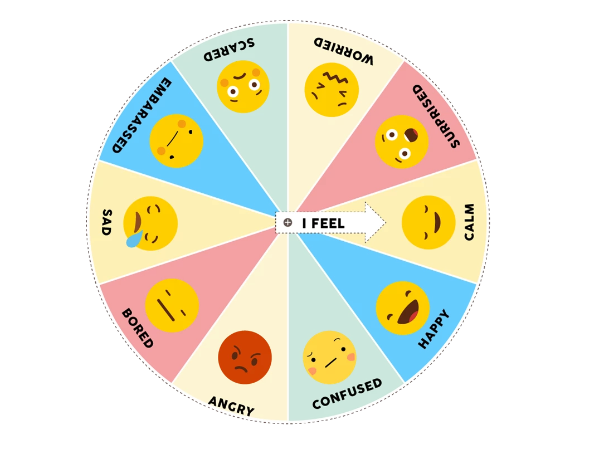Using the Feelings Wheel to Navigate Emotions
Table of Contents
As humans, we experience a wide range of emotions every day. Our emotions can be triggered by something as small as a compliment or as big as a loss. Understanding and managing these emotions can be challenging, but it’s an essential life skill that can help us improve our relationships and overall well-being. Emotional intelligence is the ability to recognize and manage our own emotions and empathize with the emotions of others.
One tool that can help us develop our emotional intelligence is the feelings wheel. In this post, we’ll explore what the feelings wheel is, how it works, and how it can help us navigate the complexities of our emotions. By learning to identify and acknowledge our emotions, we can develop greater emotional awareness and become better equipped to manage them.
Importance of Emotional Intelligence
Emotional intelligence is crucial when it comes to navigating the complexities of life. It is the ability to recognize, understand, and manage our own emotions, as well as the emotions of others. People with high levels of emotional intelligence are better equipped to handle stress, build relationships, communicate effectively, and make sound decisions.
One of the key benefits of emotional intelligence is that it allows us to develop empathy and compassion toward others. It helps us to see things from their perspective and to connect with them on a deeper level. This makes us better leaders, partners, parents, and friends.
Emotional intelligence is not something that we are born with, but rather a skill that we can develop over time. It requires self-awareness, self-regulation, motivation, empathy, and social skills. By improving our emotional intelligence, we can improve our personal and professional relationships, reduce stress and anxiety, and increase our overall happiness and well-being.
In this article, we will explore the concept of emotional intelligence in more detail, and introduce you to a powerful tool called the feelings wheel which can help you develop your emotional intelligence and navigate the complexities of emotions.
What is Emotional Intelligence?
Emotional Intelligence is the ability to recognize, understand, and manage our own emotions, while also being aware of other people’s emotions and responding to them appropriately. It is a skill that helps us navigate complex social situations and build strong relationships with others. Emotional Intelligence is not just about being aware of our own emotions; it also involves being able to empathize with others and understand their perspectives.
Emotional Intelligence has become increasingly important in the workplace, as employers recognize the value of employees who are emotionally intelligent. Emotional Intelligence can help employees to communicate effectively, manage conflicts, and work collaboratively with others. It can also help employees to manage stress, which is a common problem in today’s fast-paced, high-pressure work environments.
Emotional Intelligence is not something that we are born with, but rather a skill that can be developed and improved over time. One way to develop Emotional Intelligence is by using tools like the feelings wheel, which can help us to identify and label our emotions. This can help us to better understand our own emotional responses and manage them more effectively. By developing our Emotional Intelligence, we can improve our relationships with others, become more effective communicators, and achieve greater success in our personal and professional lives.
What is the Emotional Wheel and how it can help?
The Emotional Wheel, also known as the Feelings Wheel, is a powerful tool that can help you develop your emotional intelligence. It is a circular diagram that represents a range of emotions, with the most basic and general emotions on the outer ring and the more specific and complex emotions on the inner ring. The wheel can help you identify and understand your emotions by giving you a visual representation of the different shades of feelings that you might be experiencing.

The Emotional Wheel is particularly useful in situations where you might be struggling to name or identify your emotions. It can help you move beyond simple labels like “happy” or “sad” and explore the nuances of your emotional state. For example, you might be feeling “frustrated” but not quite sure why. By using the Emotional Wheel, you can drill down and identify that you’re actually feeling “disappointed” or “rejected,” which can help you better understand your emotional response.
The Emotional Wheel can also be a useful tool in communication. When you’re talking to someone else about your emotions, it can be challenging to find the right words to express how you feel. The Emotional Wheel can help you articulate your feelings more precisely and accurately, which can lead to more effective communication and better relationships.
Overall, the Emotional Wheel is a valuable tool that can help you develop your emotional intelligence and deepen your understanding of yourself and others. By using the wheel to explore your emotions and communicate more effectively, you can navigate the complexities of your feelings and build stronger, more meaningful relationships.
Helping Children Navigate Their Emotions
The Feelings Wheel is an effective tool for helping children identify and manage their emotions. By allowing them to express themselves in a visual and structured way, the Feelings Wheel can help children take ownership of their words and emotions. Here are some tips on helping children make the most of this useful tool:
Encouraging Open Dialogue
When introducing the concept of the Feelings Wheel to children, it’s important to emphasize that all feelings are valid. By encouraging an open dialogue about emotions, you provide a safe space for children to freely express their feelings without judgment or criticism. This creates a trusting relationship between you and your child and encourages them to unpack their feelings as they become aware of them.
Exploring New Emotions
The Feelings Wheel provides an opportunity for children to explore new forms of emotion and consider a range of feelings they may have previously been unaware of. It can also be an effective way to teach children the difference between positive and negative emotions. When discussing the Feelings Wheel, don’t forget to include descriptions of both kinds of emotions so that kids understand how they work together to form complex feelings.
Breaking Down Big Moments
Sometimes big events or experiences can make it difficult for children to process their emotions. In these cases, the Feelings Wheel can be a powerful tool for breaking down big moments into smaller parts. This allows kids to better understand each emotion they are feeling and enables them to move forward with more clarity.
Categories of Emotions
The complexity of emotions can be overwhelming, but by understanding the different categories of emotions and their subcategories, you can start to develop your emotional intelligence. The categories of emotions are:
Primary Emotions
These are the most basic emotions that are universally recognized and experienced by everyone. They include Joy, Sadness, Anger, Fear, Surprise, and Disgust.
| Emotion | Description |
|---|---|
| Joy | Happiness, delight, pleasure |
| Sadness | Sorrow, grief, unhappiness |
| Anger | Fury, frustration, rage |
| Fear | Anxiety, terror, unease |
| Surprise | Astonishment, amazement, disbelief |
| Disgust | Revulsion, aversion, repulsion |
Secondary Emotions
These are the emotions that emerge from the primary emotions and are more complex. They include Love, Guilt, Shame, and Envy.
| Emotion | Description |
|---|---|
| Optimism | Hopefulness, positivity |
| Love | Affection, deep attachment, warmth |
| Remorse | Regret, guilt, repentance |
| Curiosity | Inquisitiveness, eagerness to explore |
| Submission | Obedience, compliance, passivity |
| Contempt | Disdain, scorn, disrespect |
| Aggressiveness | Hostility, combativeness |
| Fearfulness | Nervousness, timidity, apprehension |
| Trust | Confidence, reliance, faith |
| Anticipation | Excitement, expectation |
| Disapproval | Criticism, disapprobation |
| Surprise | Startle, astonishment, bewilderment |
| Boredom | Ennui, indifference, apathy |
| Loathing | Hatred, abhorrence, disgust |
| Dominance | Control, authority, power |
| Desperation | Hopelessness, anguish, despair |
| Cautiousness | Prudence, wariness, vigilance |
| Pessimism | Negativity, cynicism, gloom |
| Awe | Reverence, admiration, wonder |
| Annoyance | Irritation, vexation, exasperation |
Tertiary Emotions
These are the emotions that are more specific and nuanced. They include Optimism, Pessimism, Sentimentality, and Awe.
Within each category, there are subcategories that further define emotions. For example, under the primary emotion of Joy, there are subcategories such as Contentment, Happiness, and Delight. Each subcategory has its own unique characteristics and can help you better understand and communicate your emotions.
By becoming familiar with the different categories and subcategories of emotions, you can start to identify and label your own emotions more accurately. This can help you manage your emotions more effectively, communicate with others more clearly, and develop stronger relationships. The feelings wheel is a useful tool that can help you visualize the different categories and subcategories of emotions and can be a helpful resource as you work to develop your emotional intelligence.
How to use the Feeling Wheel
The Feeling Wheel is an excellent tool to help you develop emotional intelligence. It is a visual representation of the different emotional states we experience and can help you identify and understand your feelings better. Here’s how to use it:
- Start by identifying the primary emotion you are feeling. Look at the center of the wheel and choose the emotion that best describes how you feel.
- Identify the shade of the emotion you are feeling. The outer ring of the wheel has shades of emotions, ranging from mild to intense. This can help you pinpoint the exact nature of your emotions.
- Once you have identified the primary emotion and its intensity, take a look at the inner ring of the wheel. This is where you’ll find the secondary emotions – the feelings that are associated with the primary emotion you’re experiencing.
- Use the Feeling Wheel as a guide to help you explore and understand your emotions better. Take a moment to reflect on your feelings and try to identify the reasons behind them.
- Practice using the Feeling Wheel regularly to develop your emotional intelligence. Over time, you’ll become more adept at identifying and managing your emotions, which will improve your relationships and overall well-being.
Using the Feeling Wheel to understand and regulate your emotions
The Feeling Wheel is a powerful tool that can help you to develop your emotional intelligence. It is a visual representation of a range of emotions, and it can help you to understand and regulate your emotions.

The Feeling Wheel is divided into several different sections, each of which represents a different category of emotions. The outermost section contains the most general emotions, such as happy, sad, angry, and scared. As you move inwards, you will find more specific emotions that fall under each category.
Using the Feeling Wheel, you can identify the specific emotions that you are feeling, and you can begin to understand the underlying causes of those emotions. This can be incredibly helpful in regulating your emotions, as it allows you to take a step back and examine your feelings from a more objective perspective.
For example, if you are feeling angry, you can use the Feeling Wheel to identify whether you are feeling frustrated, annoyed, or outraged. This can help you to understand why you are feeling angry, and it can help you to identify ways to regulate your emotions.
Developing Empathy through the Feeling Wheel
Developing empathy is essential to emotional intelligence, and the Feeling Wheel is a powerful tool that can help you to do so. Empathy is the ability to understand and share the feelings of others. When we develop empathy, we are better equipped to build meaningful relationships with people, communicate effectively, and resolve conflicts in a constructive manner.
The Feeling Wheel is a tool that can help you to identify and understand your own emotions, which is the first step towards developing empathy. By gaining a deeper understanding of your own emotional landscape, you can become more attuned to the emotions of others and develop a greater capacity for empathy.
To use the Feeling Wheel to develop empathy, start by identifying your own emotions. Look at the different categories on the wheel, such as Anger, Sadness, Joy, and Love, and try to pinpoint where your emotions fall. Once you have identified your own emotions, try to imagine how someone else might be feeling in a similar situation.
For example, if you are feeling angry because someone cut you off in traffic, try to imagine how the other driver might be feeling. Perhaps they are in a rush, or they are dealing with a personal crisis. By putting yourself in their shoes, you can develop a greater sense of empathy and understanding.
Practical applications of the Feeling Wheel
Now that we have a deeper understanding of the Feeling Wheel and how it works, let’s explore some practical applications of this tool in developing emotional intelligence.
Label your emotions
One way to use the Feeling Wheel is to identify and label your emotions. This can be especially helpful when you are feeling overwhelmed, stressed, or anxious. Take a moment to pause and reflect on how you are feeling. Then, use the Feeling Wheel to pinpoint the exact emotion you are experiencing. By doing this, you are better able to understand and manage your emotions in a healthy way.
Communication.
Another practical application of the Feeling Wheel is to use it in communication. When you are talking with someone and they express a feeling, you can use the Feeling Wheel to validate and empathize with them. For example, if your friend says they are feeling “frustrated,” you can use the Feeling Wheel to explore what’s causing their frustration and show that you understand their emotions.
Conflict Resolution.
The Feeling Wheel can also be used in conflict resolution. When there is a disagreement or conflict, it can be helpful to use the Feeling Wheel to identify and express your emotions. This can help both parties understand where the other is coming from and work towards a resolution.
How to integrate the Feeling Wheel into daily life
Integrating the Feeling Wheel into daily life can be a game-changer when it comes to developing emotional intelligence. The first step is to print out a copy of the wheel and keep it somewhere accessible, like on your fridge or desk. This way, you can refer to it whenever you feel overwhelmed by emotions or need help pinpointing what you’re feeling.
Next, start paying attention to the emotions you experience throughout the day. When you feel a strong emotion, take a moment to identify it on the Feeling Wheel. This can be especially helpful when you’re feeling a mix of emotions and aren’t sure how to label them.
As you become more comfortable using the Feeling Wheel, try to expand your emotional vocabulary. Look up the definitions of emotions you’re not familiar with and try to incorporate them into your daily life. This will help you become more precise when describing how you feel and better equipped to communicate your emotions to others.
Another way to integrate the Feeling Wheel into daily life is to use it as a tool for reflection. At the end of each day, take a few minutes to think about the emotions you experienced and how you reacted to them. Were there any patterns or triggers you noticed? Did you handle any situations particularly well or poorly? Reflecting on your emotions in this way can help you learn more about yourself and develop strategies for managing difficult emotions in the future.
Final thoughts on using the Feeling Wheel
Developing emotional intelligence is a crucial skill for anyone who wants to navigate life’s complexities successfully. Using the Feeling Wheel is a great tool to help you identify and understand your emotions, as well as those of others.
By using the Feeling Wheel, you can begin to develop your emotional vocabulary and become more aware of the nuances of emotions. This awareness can lead to better communication, stronger relationships, and improved decision-making.
Remember, emotional intelligence is not about suppressing or ignoring your emotions. It’s about recognizing and managing them in a healthy and productive way. With the Feeling Wheel, you can start to build your emotional intelligence by developing a more nuanced understanding of your own feelings and those of others.
So, whether you’re looking to improve your personal relationships, be a better leader, or just live a more fulfilling life, developing your emotional intelligence is a great place to start, and the Feeling Wheel is a great tool to help you get there.
We hope that our blog post on using the feeling wheel to develop emotional intelligence has been helpful to you. Understanding and managing our emotions can be challenging, but with the help of tools like the feeling wheel, we can become more self-aware and empathetic individuals. By learning to identify and articulate our emotions accurately, we can cultivate stronger relationships, better communication, and greater personal growth. We encourage you to continue exploring the complexities of emotions and to use the feeling wheel as a guide to help you navigate them. Remember, it’s okay to feel – understanding why and how to manage them is key.

